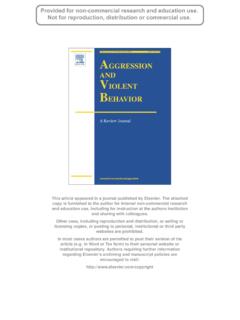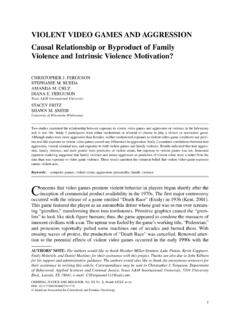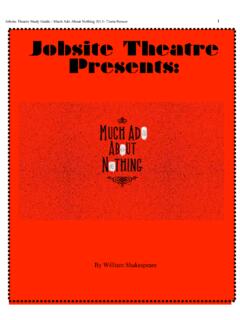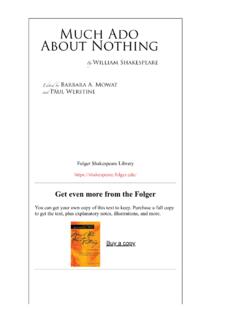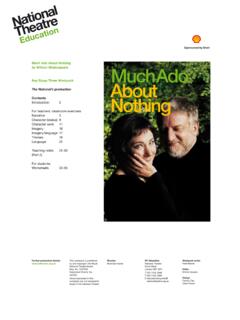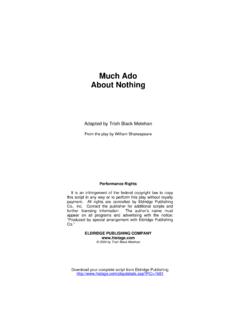Transcription of Much Ado About Nothing: The Misestimation and ...
1 APA PROOFSMuch Ado About nothing : The Misestimation and Overinterpretationof Violent Video Game Effects in Eastern and Western Nations:Comment on Anderson et al. (2010)Christopher J. Ferguson and John KilburnTexas A&M International UniversityThe issue of violent video game influences on youth violence and aggression remains intensely debatedin the scholarly literature and among the general public. Several recent meta-analyses, examiningoutcome measures most closely related to serious aggressive acts, found little evidence for a relationshipbetween violent video games and aggression or violence. In a new meta-analysis, C. A. Anderson et al.(2010) questioned these findings. However, their analysis has several methodological issues that limit theinterpretability of their results.
2 In their analysis, C. A. Anderson et al. included many studies that do notrelate well to serious aggression, an apparently biased sample of unpublished studies, and a bestpractices analysis that appears unreliable and does not consider the impact of unstandardized aggressionmeasures on the inflation of effect size estimates. They also focused on bivariate correlations rather thanbetter controlled estimates of effects. Despite a number of methodological flaws that all appear likely toinflate effect size estimates, the final estimate ofr .15 is still indicative of only weak effects. Contrastsbetween the claims of C. A. Anderson et al. (2010) and real-world data on youth violence are :computer games, mass media, youth violence, aggression, child developmentOver the last two decades, society has expressed concern thatviolent video games (VVGs) may play some role in youth vio-lence.
3 To answer some of these questions, we engaged in a seriesof precise meta-analyses of VVG studies that most closely relatedto violent outcomes ( , Ferguson, 2007; Ferguson & Kilburn,2009). Indeed, we were well aware that less precise measures tendto overestimate effects (Paik & Comstock, 1994). We also hadquestions regarding whether journals had been selectively publish-ing significant studies and potentially ignoring nonsignificant stud-ies. Our results were clear: The influence of VVGs on serious actsof aggression or violence is minimal, and publication bias is aproblem in this research field. We also noted (as did Paik &Comstock, 1994) that the best measures of aggression and violenceproduced the weakest effects and that problematic unstandardizeduse of some aggression measures, particularly in experimentalstudies, tended to inflate of Agreement and Disagreement WithAnderson et et al.
4 (2010) critiqued our analyses and offered analternative of their own. Our analyses agree that the uncorrectedestimate for VVG effects is quite small (r .15 in both analyses).We also agree that meta-analytic researchers must take carefulsteps to minimize the influence of publication bias. But our re-search groups disagree on many points: whether to include unpub-lished studies, how best to analyze and correct for publication bias,whether bivariate correlations are a proper estimate of VVG ef-fects, how precise standardized and valid aggression measuresneed to be to adequately answer research questions, and how effectsize estimates should be interpreted. We have concerns that Ander-son et al. have made several misstatements About our meta-analyses and meta-analyses more generally and have also madesignificant errors in their own analyses that render their resultsdifficult to the Perfect Meta-Analytic BeastWe are honored that Anderson et al.
5 (2010) selected our anal-yses to contrast with their own. However, readers should be awarethat other recent meta-analyses on VVGs and media violence morebroadly have been no more supportive of Anderson et al. s positionthan our own (Savage & Yancey, 2008; Sherry, 2001, 2007).Anderson et al. surprisingly cite Sherry (2001) as if supportive oftheir position, but in fact he is quite clear that he does not find theresults of his analyses persuasive for the causal position. Indeed,he is specifically critical of the Anderson et al. research group,stating, Further, why do some researchers ( , Gentile & Ander-son, 2003) continue to argue that video games are dangerousdespite evidence to the contrary? (Sherry, 2001, p.)
6 244).Anderson et al. (2010) suggested that we should have includedunpublished studies in our analyses and that the best way to negatepublication bias issues is to conduct a search for relevant studiesthat is thorough, systematic, unbiased, transparent, and clearlydocumented (p. xx). We note that, given that one of our questionsChristopher J. Ferguson and John Kilburn, Department of Behavioral,Applied Sciences and Criminal Justice, Texas A&M International concerning this article should be addressed to Christo-pher J. Ferguson, Department of Behavioral, Applied Sciences and Crim-inal Justice, Texas A&M International University, Laredo, TX : Bulletin 2010 American Psychological Association2010, Vol. , No.
7 , 000 0000033-2909/10/$ DOI: S 1 12/23/09 7:13 Art: 2009-0286 APA PROOFS specifically regarded the amount of bias in the published literature,including unpublished studies would be counterintuitive. Althoughincluding unpublished studies in meta-analyses is certainly com-mon, is it really as widely accepted as they claim? Further, doestheir meta-analysis live up to their own rhetoric?First, Anderson et al. (2010) failed to note that many scholarshave been critical of the inclusion of unpublished studies in meta-analyses. Baumeister, DeWall, and Vohs (2009) noted that oneweakness of meta-analysis is that the inclusion of dubious unpub-lished works can muddy the waters (p. 490). Smith and Egger(1998), echoing our own concerns, noted that including unpub-lished studies increases bias, particularly when located studies arenot representative of the broader array of studies.
8 Others havenoted that inclusion of unpublished studies remains controversial,although certainly common, and it is not uncommon for meta-analyses to avoid unpublished studies (Cook et al., 1993). Thus,Anderson et al. s implication that we essentially invented thenotion of avoiding unpublished studies is fanciful, much as wewould like to take the comments of Anderson et al. (2010) supporting asearch for unpublished studies that is thorough, systematic, un-biased, transparent, and clearly documented, they actually pro-vide little information About how they located unpublished , one common procedure, although certainly not suffi-cient in and of itself, is to request unpublished studies from knownresearchers in the field (Egger & Smith, 1998).
9 It is surprising thenthat, although the Anderson et al. researchers were in contact withus ( , C. J. Ferguson), they neither mentioned their meta-analysisnor requested in-press or unpublished studies. As such, theymissed several in-press studies ( , Ferguson & Rueda, in press;Ferguson, San Miguel, & Hartley, 2009) as well as a larger numberof on review papers and papers for which data had been col-lected but not yet written up. We express the concern that otherresearch groups that, arguably, have presented research not in linewith Anderson et al. s hypotheses may not have been contacted( , Barnett, Coulson, & Foreman, 2008; Colwell & Kato, 2003;Kutner & Olson, 2008; Ryan, Rigby, & Przybylski, 2006; Un-sworth, Devilly, & Ward, 2007; Williams & Skoric, 2005).
10 Forexample, we note that several published reports ( , Barnett et al.,2008; Olson et al., 2009; Przybylski, Weinstein, Ryan, & Rigby,2009) from this group of authors have been missed. Thus, fromonly a small group of researchers, albeit those who differ fromAnderson et al. in perspective, a considerable number of published,in-press, and unpublished studies were missed. One can onlyspeculate at the number of other missed studies from unknownauthors. On the other hand, when examining the appendix ofincluded studies, one finds that unpublished studies from Andersonet al. s research group and colleagues are well represented. Forexample, of two unpublished studies, both are from Anderson etal. s broader research group.
